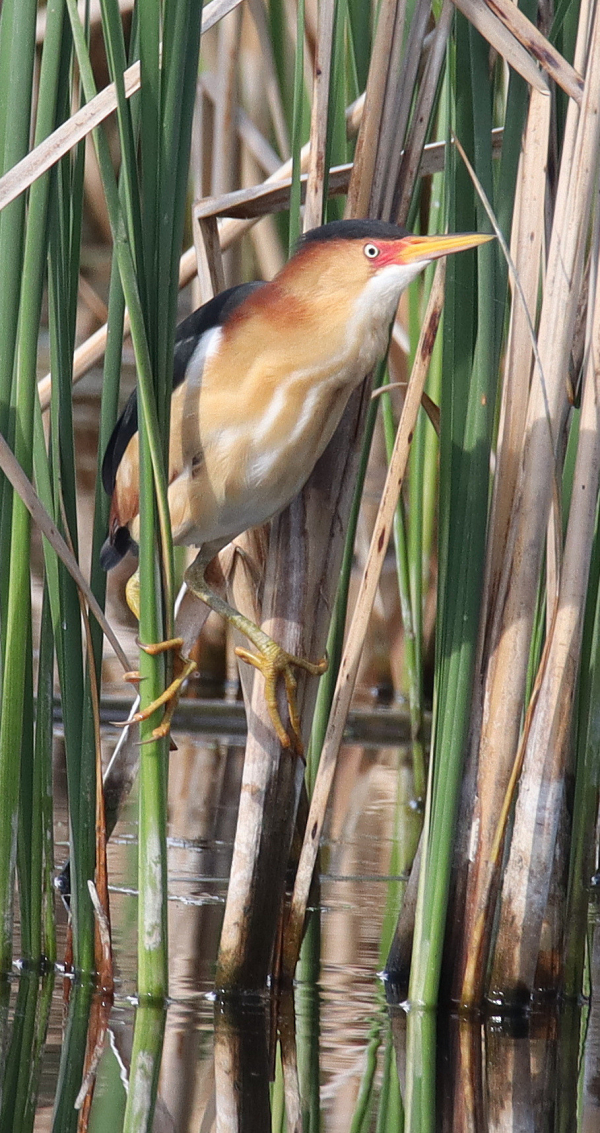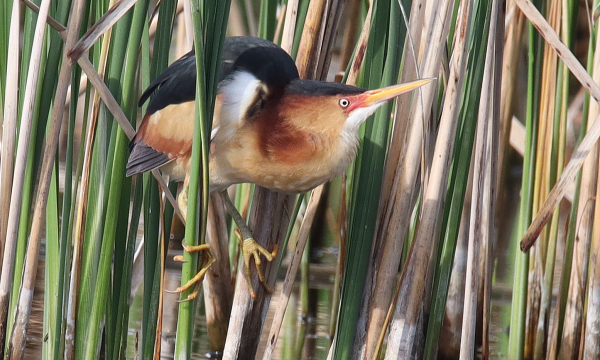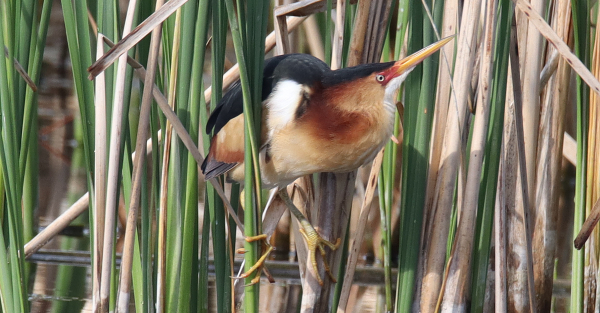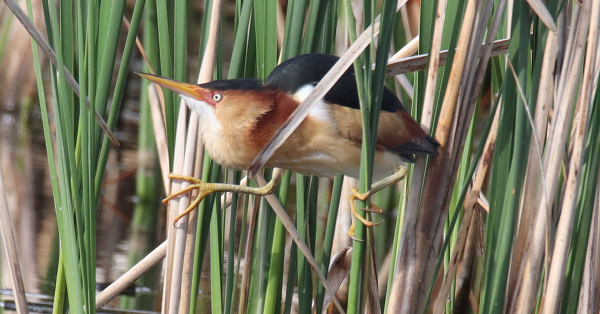In spite of the passing single-cloud rains that were mixed with bouts of sunshine, after waiting to take a photo trip to the Hecla Marsh for days I gambled on the sun breaking through by the time I arrived late Saturday afternoon. That’s quite a gamble, but right on que the sun broke through the cover of a tall cumulous cloud, providing nice sunlight for me to focus on a couple White-faced Ibis taking flight, a pair of Giant Canada Geese with a week-old brood of 11 goslings, followed by the surprise of the week flew into view. I couldn’t have planned on it, nor did I begin to imagine it, but to my right side a Least Bittern flew into view, followed closely by a second one!

As the Least Bittern stretched out from behind the wall of cattails, it was positioned quite upright with its feet clinging to cattail stalks in what seemed to be a most uncomfortable position. How lucky was Paul to be in position to photograph the rare bird in improving sunlight? (All photos: 600mm zoom lens, f-8 aperture, 1/320 shutter speed, ISO 400.)
|
Please appreciate, the only Least Bitterns I can remember seeing were in southern California and south Texas, only 2, so this was quite a surprise. I stopped my mobile blind and grabbed my camera simultaneously on the vacated road as the first Least Bittern landed on the shore near the road. The second bittern kept flying across my view but vanished into the nearest cattails on the opposite side of the road – to my left. Focusing my attention on the first bittern, I tried to ease forward, but couldn’t really see the small bird – until it flew up, angled a half-circle on the left side of the road (my side) and landed on the edge of a wall of cattails just above the water level.
I tried to follow the bittern through my camera lens as it made its low flight, but after the fact I learned those foto attempts weren’t in focus, which was not unexpected, but it’s always worth a try. Now the Least Bittern was almost hidden behind the edge of cattails, but as I pressed the shutter button to focus on the location, the bittern began to emerge from behind the wall of cattails! Would it provide some classic images? As it first stretched its beak, head, and neck forward, I began taking what would become a series of photos.
At first the bittern was positioned quite upright with its feet clinging to cattail stalks in what seemed to be a most uncomfortable position, but in the process it provided an opening photograph that would be my first non-blurred image of a Least Bittern – ever. From that position it lowered its head and stretched a bit farther forward to show more of its body, which is when I thought could hear it calling. The sound was quite low, and I couldn’t tell if it was opening its beak to call, so I just kept photographing as it changed position, turning its head from side to side momentarily. That’s when I heard a responsive call from another Least Bittern located where the other bird landed. The 2 bitterns called back and forth, and I believed they were a male and female, but not knowing Least Bittern behavior, they may have been 2 territorial males.
After a few moments of calling, the bittern I was photographing pulled its neck and body back into the cattails and turned 180 degrees to face in the opposite direction and stretch its head and neck forward to call from that position. The bittern didn’t stay there for long, possibly because it seemed to be caught in the grasp of a dry cattail stem (see the last photo). Nonetheless it called again, acting a bit more excited, was answered, and it took a short flight to land nearer the other bird, out of my view within the thick cattail growth.
As with so many unexpected photo ops that I’ve benefitted from lately, a bird that’s not at all on my radar comes into view and provides some moments or some minutes of photo chances. In response, I make the most of the brief interludes, and then the surprise bird is gone. It’s great fun while it lasts though, that’s for sure! And I try to make the most of the opportunity for as long as it lasts.

When I reviewed the photos on my computer that evening, I verified that the Least Bittern never opened its beak while calling, but you can see feathers on its throat that appear to be moving in response to guttural actions while it called. That’s when I also began thinking about how these small wading birds didn’t resemble the other much more common bittern in the area, the American Bittern. Americans are so much larger, with comparatively longer necks, and their calls are much louder.
With that huge variation in mind between the American and Least Bitterns, I wondered about the total number of bittern species, so checked into Birds of the World, which detailed that there are 13 species of bitterns world-wide – 11 beyond the United States and Canada. Also, as its name implies the Least Bittern is heralded as the smallest of all the herons. Among the calls described for the species, “males utter a dove-like cooing heard in spring,” which is somewhat like the low calls emitted by the 2 Least Bitterns I heard, although I wouldn’t describe it as “cooing.”

Photography Insights
Although I wasn’t very close to the Least Bittern as I photographed it, I wasn’t that far away either. I had my Tamron 150-to-600mm zoom lens zeroed in at its full 600mm focal length, but as we all do, I would have liked to zoom closer – ha. Instead, I “zoomed closer” in my digital darkroom, using my photo editing software, by cropping much of the extraneous surrounding landscape (cattails) from the best photos. The resulting images provided adequately sharp images for me, although I always appreciate that I sometime push the sharpness envelope a bit in the process. Overall though, the photos make me appreciate the quality of images produced by the Tamron ultra-zoom lens.
As for the tech settings, I took the photos using an aperture of f-8, which provided a wide field in focus, but it also reduced the shutter speed to 1/320 of a second. That relatively slow shutter speed worked fine when the bird was almost motionless and I steadied the camera and lens on the frame of my open car window. Honestly, I used the settings I selected to photograph the goose family before crossing paths with the Least Bitterns, and didn’t have a chance to double-check my settings during the quick action. You can always second guess the settings after the fact, but no wonder the flight photos I tried to take as the bittern landed were blurred with a 1/320 shutter speed in low light among the cattails.

I’m glad for the chance to share these images and the story behind them with you, and I’m really happy I’m a birder! Birding with my camera provides almost daily levels of excitement that add immeasurably to my personal well-being and happiness, frankly. I always have something to look forward to, plus the end result of taking some photographs of the birds is especially rewarding. Can’t wait to go birding tomorrow! Good Luck as you give your camera a workout during June!
Article and photographs by Paul Konrad
Share your bird photos and birding experiences at editorstbw2@gmail.com